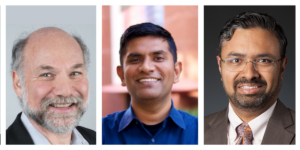Only two years after joining USC straight from graduate school at Cornell, Bhaskar Krishnamachari has won a prestigious NSF faculty early career development grant.
The new assistant professor, who has a joint appointment in the USC Viterbi School of Engineering departments of electrical engineering/systems and computer science, also works with ISI’s computer networks division.Despite his youth, Krishnamachari already has more than 60 book chapters, journal publications, conference papers, invited speeches and technical reports to his credit.
His field is autonomous networks, particularly wireless sensor networks – studies of ways to create and maintain self-governing “republics” of individual units who cooperate with each other to monitor an environment with minimal power and maximum coverage.
Such networks can provide – in the words of the NSF award citation – “high resolution interfaces between the physical and virtual world.” They have applications ranging from pollution control to security to industrial quality monitoring to systems that can give timely warning of structural problems in vehicles or buildings.
Krishnamachari’s early career grant includes a commitment not only to research, but to education at the graduate and undergraduate level, “as well as outreach to public high school students in Los Angeles.”
Krishnamachari is also co-principal investigator on a recent multidisciplinary NSF Information Technology Research Grant entitled “Structural Health Monitoring Using Local Excitation and Large-Scale Networked Sensing.
The principal investigator on the grant is Ramesh Govindan of Computer Science. Other collaborating faculty include Gaurav Sukhatme (Computer Science) and Erik Johnson and Sam Masri (Civil Engineering).
Structural Health Monitoring (SHM) is a highly interdisciplinary area of research focused on developing techniques to detect damage in structures such as buildings, bridges, aircraft, ships and spacecraft.
The proposed project will use decentralized local excitation and high- resolution measurements of response to these excitations, detected and collaboratively analyzed through a spatially dense wireless network of devices.
This technique promises simpler and more accurate techniques to identify and even localize damage within the structure.
Published on April 7th, 2004
Last updated on August 9th, 2021










